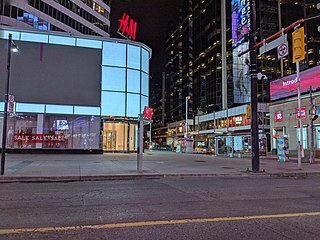
The Regional Municipality of York, also called York Region, is a regional municipality in Southern Ontario, Canada, between Lake Simcoe and Toronto. The region was established after the passing of then Bill 102, An Act to Establish The Regional Municipality of York, in 1970. It replaced the former York County in 1971, and is part of the Greater Toronto Area and the inner ring of the Golden Horseshoe. The regional government is headquartered in Newmarket.
York Region Transit (YRT) is the public transit operator in York Region, Ontario, Canada. Its headquarters are in Richmond Hill, at 50 High Tech Road.

The York Regional Police (YRP) is the police service of the Regional Municipality of York, Ontario, Canada. YRP was formed in 1971 from the police forces maintained by the nine municipalities which amalgamated into York Region at the time. The force had a strength of over 1,500 sworn members and 618 unsworn members as of 2015.

Viva is the bus rapid transit operations of York Region Transit in York Region, Ontario, Canada. Viva service forms the spine for YRT's local bus service, providing seamless transit service across York Region with connections to northern Toronto.

The COVID-19 pandemic in Canada is part of the ongoing worldwide pandemic of coronavirus disease 2019. It is caused by severe acute respiratory syndrome coronavirus 2. Most cases over the course of the pandemic have been in Ontario, Quebec, British Columbia and Alberta. Confirmed cases have been reported in all of Canada's provinces and territories.
On 9 March 2020, the government of Italy under Prime Minister Giuseppe Conte imposed a national lockdown or quarantine, restricting the movement of the population except for necessity, work, and health circumstances, in response to the growing pandemic of COVID-19 in the country. Additional lockdown restrictions mandated the temporary closure of non-essential shops and businesses. This followed a restriction announced on the previous day which affected sixteen million people in the whole region of Lombardy and in fourteen largely-neighbouring provinces in Emilia-Romagna, Veneto, Piedmont and Marche, and prior to that a smaller-scale lockdown of ten municipalities in the province of Lodi and one in the province of Padua that had begun in late February.

National responses to the COVID-19 pandemic have been varied, and have included containment measures such as lockdowns, quarantines, and curfews. As of 18 May 2023, 766,440,032 cases of COVID-19 have been reported, resulting in 6,932,578 reported deaths. The most affected countries in terms of confirmed cases are the United States, Brazil, India, Russia, South Africa, Peru, Mexico, Chile, the United Kingdom, and Iran.

The COVID-19 pandemic in Sierra Leone is part of the ongoing worldwide pandemic of coronavirus disease 2019 caused by severe acute respiratory syndrome coronavirus 2. The virus was confirmed to have reached Sierra Leone on 31 March 2020.

The COVID-19 pandemic in Ontario is an ongoing viral pandemic of coronavirus disease 2019 (COVID-19), a novel infectious disease caused by severe acute respiratory syndrome coronavirus 2 (SARS-CoV-2). The first confirmed case of COVID-19 in Canada was announced on January 25, 2020, involving a traveller who had recently returned to Toronto from travel in China, including Wuhan. Ontario has had the largest number of confirmed COVID-19 cases among Canada's provinces and territories, but due to having the largest population, only ranks sixth adjusted per capita. Ontario surpassed one million lab-confirmed COVID-19 cases on January 24, 2022; one day before the anniversary of the first confirmed case on January 25, 2020.

The COVID-19 pandemic in the Bahamas was a part of the COVID-19 pandemic of coronavirus disease 2019 (COVID-19). The outbreak was identified in Wuhan, Hubei, China, in December 2019, declared to be a Public Health Emergency of International Concern on 30 January 2020, and recognised as a pandemic by the World Health Organization on 11 March 2020. It was confirmed to have reached the Bahamas on 15 March 2020 with the announcement of the first case.

Due to the COVID-19 pandemic, a number of non-pharmaceutical interventions colloquially known as lockdowns have been implemented in numerous countries and territories around the world. These restrictions were established with the intention to reduce the spread of SARS-CoV-2, the virus that causes COVID-19. By April 2020, about half of the world's population was under some form of lockdown, with more than 3.9 billion people in more than 90 countries or territories having been asked or ordered to stay at home by their governments. Although similar disease control measures have been used for hundreds of years, the scale of those implemented in the 2020s is thought to be unprecedented.
The COVID-19 pandemic is an ongoing viral pandemic of coronavirus disease 2019 (COVID-19), a novel infectious disease caused by severe acute respiratory syndrome coronavirus 2 (SARS-CoV-2). The pandemic has affected the Cities of Mississauga and Brampton, and the Town of Caledon, within the Regional Municipality of Peel. As part of the larger closure decisions in Ontario, a stay-at-home order shuttered all nonessential businesses, and caused event cancellations.
The COVID-19 pandemic in Toronto is an ongoing viral pandemic of coronavirus disease 2019 (COVID-19), a novel infectious disease caused by severe acute respiratory syndrome coronavirus 2 (SARS-CoV-2). Toronto is the most populous city in Canada, and the fourth most populous city in North America.

The COVID-19 pandemic in Ottawa is part of the global ongoing viral pandemic of coronavirus disease 2019 (COVID-19), a novel infectious disease caused by severe acute respiratory syndrome coronavirus 2 (SARS-CoV-2). Ottawa is the 4th most populous city in Canada, the second largest city in Ontario, and the capital city of Canada.

Africa's first confirmed case of COVID-19 was announced in Egypt on 14 February 2020. Many preventive measures have been implemented in different countries in Africa, including travel restrictions, flight cancellations, event cancellations, school closures, and border closures. Other measures to contain and limit the spread of the virus has included curfews, lockdowns, and enforcing the wearing of face masks. The virus has spread throughout the continent. Lesotho, the last African sovereign state to have remained free of the virus, reported a case on 13 May 2020.
The COVID-19 pandemic in Queensland is part of the ongoing worldwide pandemic of the coronavirus disease 2019 caused by severe acute respiratory syndrome coronavirus 2.

The COVID-19 pandemic in Western Australia is part of the ongoing worldwide pandemic caused by severe acute respiratory syndrome coronavirus 2. Western Australia (WA) confirmed its first case of COVID-19 on 21 February 2020, and its first death on 1 March. On 15 March, premier Mark McGowan declared a state of emergency. On 24 March, Western Australia closed its borders to the rest of Australia, and on 1 April, the state implemented borders between regions in the state. By mid-April 2020, the state had eliminated community transmission of COVID-19, becoming one of the few places in the world to do so. There were only a handful of cases of community transmission in the state after mid-April, until late December 2021 when a tourist caused an outbreak that led to the cancelling of some New Year's Eve events, and the re-imposing of mask wearing rules in Perth and the Peel region.
The COVID-19 pandemic in Tasmania is part of the ongoing worldwide pandemic of the coronavirus disease 2019 caused by severe acute respiratory syndrome coronavirus 2.

Countries and territories around the world enforced lockdowns of varying stringency in response to the COVID-19 pandemic.

The following has been the provincial governmental response to the COVID-19 pandemic in Ontario.












